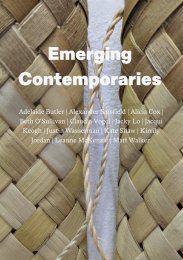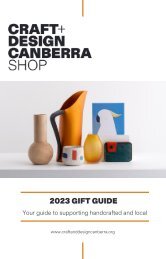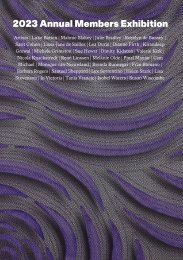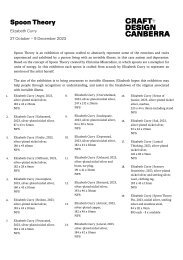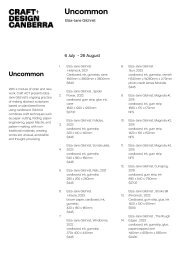Shifts in Japanese Materiality
11 July – 31 August 2019 Bic Tieu | Guy Keulemans | Julie Bartholomew | Kyoko Hashimoto | Liam Mugavin | Rui Kikuchi | Yusuke Takemura This group exhibition of contemporary design practice considers the changing nature of materiality in Japanese object-making culture. Through the work of experimental Japanese and Australian designers, Shifts in Japanese Materiality highlights the porosity of Japanese design and craft processes in a contemporary context.
11 July – 31 August 2019
Bic Tieu | Guy Keulemans | Julie Bartholomew | Kyoko Hashimoto | Liam Mugavin | Rui Kikuchi | Yusuke Takemura
This group exhibition of contemporary design practice considers the changing nature of materiality in Japanese object-making culture. Through the work of experimental Japanese and Australian designers, Shifts in Japanese Materiality highlights the porosity of Japanese design and craft processes in a contemporary context.
You also want an ePaper? Increase the reach of your titles
YUMPU automatically turns print PDFs into web optimized ePapers that Google loves.
stage. Before that, the pellets or<br />
chemical feedstock likely came from<br />
Japan, though perhaps Germany or<br />
elsewhere. And before that, the fossil<br />
fuel raw material could be Middle<br />
Eastern crude oil or gas from the North<br />
Sea. Or gas from Australia, as Japan is<br />
Australia’s biggest buyer.<br />
Kyoko Hashimoto<br />
Artist Statement<br />
Japan, as an island nation, had a<br />
natural limit to its resources. Now,<br />
<strong>in</strong> the global economy, Japan is the<br />
biggest importer of natural gas and the<br />
second largest importer of crude oil.<br />
Both are used to produce goods made<br />
from synthetic plastics, of which Japan<br />
is the world’s eighth largest exporter.<br />
This rank<strong>in</strong>g might not <strong>in</strong>clude the<br />
export of petrochemical feedstock,<br />
the raw chemicals used to make plastic<br />
pellets, or the pellets themselves.<br />
Due to account<strong>in</strong>g and term<strong>in</strong>ology<br />
complexities of global trade, it’s hard<br />
to know.<br />
Given the significance of global<br />
material flows and their dom<strong>in</strong>ance<br />
over traditional craft materials <strong>in</strong> both<br />
volume and economic value, I question<br />
whether I can mean<strong>in</strong>gfully def<strong>in</strong>e<br />
‘<strong>Japanese</strong> materiality’ <strong>in</strong> contemporary<br />
terms.<br />
Nenju are the <strong>Japanese</strong> form of<br />
Buddhist prayer beads. Traditionally<br />
made from wood or stone, the soft<br />
gr<strong>in</strong>d<strong>in</strong>g noise that results from their<br />
manipulation <strong>in</strong> the hand is said to<br />
focus the m<strong>in</strong>d on the failures of human<br />
passions. The Nenju presented here<br />
are made from the materials of plastic<br />
toys used, broken and discarded by my<br />
children<br />
And it’s hard to know where any<br />
particular plastic product really<br />
orig<strong>in</strong>ates. A plastic toy might<br />
bestamped ‘Made <strong>in</strong> Ch<strong>in</strong>a’, but this<br />
only refers to a f<strong>in</strong>al manufactur<strong>in</strong>g<br />
38






